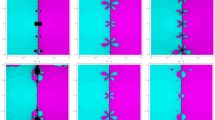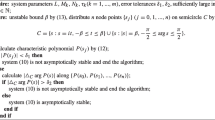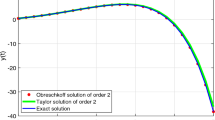Abstract
Evolutionary techniques are used for the derivation of a six-stage sixth-order singly diagonally implicit Runge–Kutta–Nyström (SDIRKN) method for the integration of second-order initial value problems (IVPs). This method is P-stable and is recommended for stiff and mildly stiff problems possessing an oscillatory solution. It also attains an order which is one higher than existing methods of this type. Thus, it outperforms the other existing methods of this type when applied to relevant systems of IVPs arising from the semi-disrcetization of partial differential equations (PDEs) with the method of lines (MoL).
Similar content being viewed by others
References
Van Der Houwen, P.J., Sommeijer, B.P., Cong, N.H.: Stability of collocation-based Runge–Kutta–Nyström methods. BIT 31, 469–481 (1991)
Schiesser, W.E., Griffiths, G.W.: A Compendium of Partial Differential Equation Models: Method of Lines Analysis with Matlab. Cambridge University Press, Cambridge (2009)
Bratsos, A.G., Tsitouras, Ch., Natsis, D.G.: Linearized numerical schemes for the Boussinesq equation. Appl. Numer. Anal. Comput. Math. 2, 34–53 (2005)
Tsitouras, Ch., Famelis, I.T.: Quadratic Störmer-type methods for the solution of the Boussinesq equation by the method of lines. Numer. Methods Partial Differ. Equ. 24, 1321–1328 (2008)
Berg, D.B., Simos, T.E., Tsitouras, Ch.: Trigonometric fitted, eighth-order explicit Numerov-type methods. Math. Methods Appl. Sci. 41, 1845–1854 (2018)
Medvedev, M.A., Simos, T.E., Tsitouras, Ch.: Fitted modifications of Runge-Kutta pairs of orders 6(5). Math. Methods Appl. Sci. 41, 6184–6194 (2018)
Medvedev, M.A., Simos, T.E., Tsitouras, Ch.: Trigonometric-fitted hybrid four-step methods of sixth order for solving \(y^{\prime \prime }=f(x, y)\). Math. Methods Appl. Sci. 42, 710–716 (2019)
Medvedev, M.A., Simos, T.E., Tsitouras, Ch.: Hybrid, phase-fitted, four-step methods of seventh order for solving \(x^{\prime \prime }(t) = f (t, x)\). Math. Methods Appl. Sci. 42, 2025–2032 (2019)
Ramos, H., Kalogiratou, Z., Monovasilis, Th, Simos, T.E.: An optimized two-step hybrid block method for solving general second order initial-value problems. Numer. Algorithms 72, 1089–1102 (2016)
Simos, T.E.: High order closed Newton–Cotes trigonometrically-fitted formulae for the numerical solution of the Schrödinger equation. Appl. Math. Comput. 209, 137–151 (2009)
Simos, T.E.: Closed Newton–Cotes trigonometrically-fitted formulae of high order for long-time integration of orbital problems. Appl. Math. Lett. 22, 1616–1621 (2009)
Simos, T.E.: New stable closed Newton–Cotes trigonometrically fitted formulae for long-time integration. Abstr. Appl. Anal. 2012 (2012). https://doi.org/10.1155/2012/182536 (Article ID 182536)
Simos, T.E.: Optimizing a hybrid two-step method for the numerical solution of the Schrödinger equation and related problems with respect to phase-lag. J. Appl. Math. 2012 (2012). https://doi.org/10.1155/2012/420387 (Article ID 420387)
Tsitouras, Ch., Th, I., Famelis, I.T., Simos, T.E.: Phase-fitted Runge-Kutta pairs of orders 8(7). J. Comput. Appl. Math. 321, 226–231 (2017)
Tsitouras, Ch., Simos, T.E.: Trigonometric fitted explicit Numerov type method with vanishing phase-lag and its first and second derivatives. Mediterr. J. Math. 15, 168 (2018)
Kalogiratou, Z., Monovasilis, Th, Simos, T.E.: New modified Runge–Kutta–Nystrom methods for the numerical integration of the Schrödinger equation. Comput. Math. Appl. 60, 1639–1647 (2010)
Kosti, A.A., Anastassi, Z.A., Simos, T.E.: Construction of an optimized explicit Runge–Kutta–Nyström method for the numerical solution of oscillatory initial value problems. Comput. Math. Appl. 61, 3381–3390 (2011)
Monovasilis, Th, Kalogiratou, Z., Simos, T.E.: Exponentially fitted symplectic Runge–Kutta–Nyström methods. Appl. Math. Inf. Sci. 7, 81–85 (2013)
Monovasilis, T., Kalogiratou, Z., Simos, T.E.: Construction of exponentially fitted symplectic Runge–Kutta–Nyström methods from partitioned Runge–Kutta methods. Mediterr. J. Math. 13, 2271–2285 (2016)
Papadopoulos, D.F., Simos, T.E.: A modified Runge–Kutta–Nyström method by using phase lag properties for the numerical solution of orbital problems. Appl. Math. Inf. Sci. 7, 433–437 (2013)
Papadopoulos, D.F., Simos, T.E.: The use of phase lag and amplification error derivatives for the construction of a modified Runge–Kutta–Nyström method. Abstr. Appl. Anal. 2013 (2013) (Article ID: 910624)
Butcher, J.C.: Implicit Runge–Kutta processes. Math. Comput. 18, 50–64 (1964)
Butcher, J.C.: On Runge–Kutta processes of high order. J. Aust. Math. Soc. 4, 179–194 (1964)
Van der Houwen, P.J., Sommeijer, B.P.: Diagonally implicit Runge–Kutta–Nyström methods for oscillatory problems. SIAM J. Numer. Anal. 26, 414–429 (1989)
Sharp, P.W., Fine, J.M., Burrage, K.: Two-stage and three-stage diagonally implicit Runge–Kutta–Nyström methods of order three and four. IMA J. Numer. Anal. 10, 489–504 (1990)
Papageorgiou, G., Famelis, I.T., Tsitouras, C.: A P-stable singly diagonally implicit Runge–Kutta–Nyström method. Numer. Algorithms 17, 345–353 (1998)
Tsitouras, Ch.: Stage reduction on P-stable Numerov type methods of eighth order. J. Comput. Appl. Math. 191, 297–305 (2006)
Hairer, E., Wanner, G.: Solving Ordinary Differential Equations II, Stiff and Differential-Algebraic Problems, 2nd edn. Springer, Berlin (1996)
Dong, Ming, Simos, T.E.: A new high algebraic order efficient finite difference method for the solution of the Schrödinger equation. Filomat 31, 4999–5012 (2017)
Hui, Fei, Simos, T.E.: Four stages symmetric two-step P-stable method with vanished phase-lag and its first, second, third and fourth derivatives. Appl. Comput. Math. 15, 220–238 (2016)
Zhang, Wei, Simos, T.E.: A high-order two-step phase-fitted method for the numerical solution of the Schrödinger equation. Mediterr. J. Math. 13, 5177–5194 (2016)
Panopoulos, G.A., Simos, T.E.: An optimized symmetric 8-step semi-embedded predictor–corrector method for IVPs with oscillating solutions. Appl. Math. Inf. Sci. 7, 73–80 (2013)
Panopoulos, G.A., Simos, T.E.: A new optimized symmetric embedded predictor–corrector method (EPCM) for initial-value problems with oscillatory solutions. Appl. Math. Inf. Sci. 8, 703–713 (2014)
Panopoulos, G.A., Simos, T.E.: An eight-step semi-embedded predictor-corrector method for orbital problems and related IVPs with oscillatory solutions for which the frequency is unknown. J. Comput. Appl. Math. 290, 1–15 (2015)
Papakostas, S.N., Tsitouras, Ch.: High phase-lag order Runge–Kutta and Nyström pairs. SIAM J. Sci. Comput. 21, 747–763 (1999)
Alolyan, I., Anastassi, Z.A., Simos, T.E.: A new family of symmetric linear four-step methods for the efficient integration of the Schrödinger equation and related oscillatory problems. Appl. Math. Comput. 218, 5370–5382 (2012)
Anastassi, Z.A., Simos, T.E.: A parametric symmetric linear four-step method for the efficient integration of the Schrödinger equation and related oscillatory problems. J. Comput. Appl. Math. 236, 3880–3889 (2012)
Kalogiratou, Z., Monovasilis, Th, Ramos, Higinio, Simos, T.E.: A new approach on the construction of trigonometrically fitted two step hybrid methods. J. Comput. Appl. Math. 303, 146–155 (2016)
Simos, T.E.: Exponentially and trigonometrically fitted methods for the solution of the Schrödinger equation. Acta Appl. Math. 110, 1331–1352 (2010)
Simos, T.E.: On the explicit four-step methods with vanished phase-lag and its first derivative. Appl. Math. Inf. Sci. 8, 447–458 (2014)
Simos, T.E.: Multistage symmetric two-step P-stable method with vanished phase-lag and its first, second and third derivatives. Appl. Comput. Math. 14, 296–315 (2015)
Stavroyiannis, S., Simos, T.E.: Optimization as a function of the phase-lag order of nonlinear explicit two-step P-stable method for linear periodic IVPs. Appl. Numer. Math. 59, 2467–2474 (2009)
Simos, T.E., Tsitouras, Ch., Famelis, I.T.: Explicit Numerov type methods with constant coefficients: a review. Appl. Comput. Math. 16, 89–113 (2017)
Simos, T.E., Tsitouras, Ch.: A new family of 7 stages, eighth-order explicit Numerov-type methods. Math. Methods Appl. Sci. 40, 7867–7878 (2017)
Tsitouras, Ch., Famelis, I.T.: Symbolic derivation of Runge-Kutta-Nyström order conditions. J. Math. Chem. 46, 896–912 (2009)
Wolfram Research, Inc., Mathematica, Version 11.1. Wolfram Research, Inc., Champaign (2017)
Famelis, I.T., Papakostas, S.N., Tsitouras, Ch.: Symbolic derivation of Runge-Kutta order conditions. J. Symb. Comput. 37, 311–327 (2004)
Tsitouras, Ch., Famelis, I.T., Simos, T.E.: On modified Runge–Kutta trees and methods. Comput. Math. Appl. 62, 2101–2111 (2011)
Famelis, I.T., Tsitouras, Ch.: Symbolic derivation of order conditions for hybrid Numerov-type methods solving \(y^{\prime \prime }=f(x, y)\). J. Comput. Appl. Math. 218, 543–555 (2008)
Storn, R., Price, K.: Differential evolution—a simple and efficient heuristic for global optimization over continuous spaces. J. Glob. Optim. 11, 341–359 (1997)
Simos, T.E., Tsitouras, Ch.: Evolutionary generation of high order, explicit, two step methods for second order linear IVPs. Math. Meth. Appl. Sci. 40, 6276–6284 (2017)
Franco, J.M., Gómez, I., Rández, L.: Four-stage symplectic and P-stable SDIRKN methods with dispersion of high order. Numer. Algorithms 26, 347–363 (2001)
Alonso-Mallo, I., Cano, B., Moreta, M.J.: Stability of Runge–Kutta–Nyström methods. J. Comput. Appl. Maths. 189, 120–131 (2006)
Alolyan, I., Simos, T.E.: A family of high-order multistep methods with vanished phase-lag and its derivatives for the numerical solution of the Schrödinger equation. Comput. Math. Appl. 62, 3756–3774 (2011)
Simos, T.E., Tsitouras, Ch.: Fitted modifications of classical Runge–Kutta pairs of orders 5(4). Math. Methods Appl. Sci. 41, 4549–4559 (2018). https://doi.org/10.1002/mma.4913
Simos, T.E., Tsitouras, Ch.: Fitted modifications of Runge–Kutta pairs of orders 6(5). Math. Methods Appl. Sci. 41, 6184–6194 (2018). https://doi.org/10.1002/mma.5128
Tsitouras, Ch.: Optimized explicit Runge–Kutta pair of orders 9(8). Appl. Numer. Math. 38, 123–134 (2001)
Tsitouras, Ch., Simos, T.E.: On ninth order, explicit Numerov type methods with constant coefficients. Mediterr. J. Math. 15 (2018) (Article No: 46)
Author information
Authors and Affiliations
Corresponding author
Additional information
Publisher's Note
Springer Nature remains neutral with regard to jurisdictional claims in published maps and institutional affiliations.
Appendix
Appendix
Mathematica verification of the above follows. All computations are valid to quadruple precision.
The coefficients at 32 digits of accuracy.

Satisfaction of order conditions listed in Table 2.

Estimation of principal truncation coefficients norms \(\left\| T^{(7)}\right\| _2\,\mathrm{and}\left\| T^{\prime (7)}\right\| _2\).

Construction of propagation matrix \(R(z)\equiv R(v^2)\).

Verification that \(P\equiv 1\) over a wide range of values \(v\in [0,20]\).

Verification that \(|S(v^2)|\le 2\).

The reader may also verify \(|S(v^2)|\le 2\) by plotting \(S(v^2)\).

The numerical tests in this paper were performed in double precision which is appropriate for a sixth-order method. Writing now:

etc., we may also verify that the above are valid for double precision also.
Rights and permissions
About this article
Cite this article
Lin, C., Chen, J.J., Simos, T.E. et al. Evolutionary Derivation of Sixth-Order P-stable SDIRKN Methods for the Solution of PDEs with the Method of Lines. Mediterr. J. Math. 16, 69 (2019). https://doi.org/10.1007/s00009-019-1336-8
Received:
Accepted:
Published:
DOI: https://doi.org/10.1007/s00009-019-1336-8




